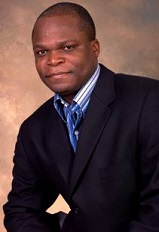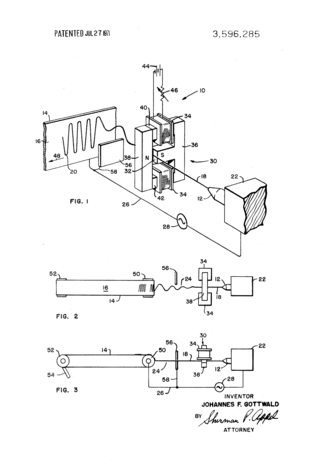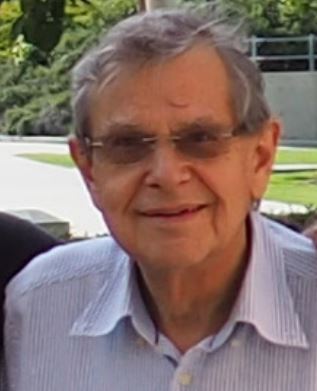Electrowetting is the modification of the wetting properties of a surface with an applied electric field.

Willis Haviland Carrier was an American engineer, best known for inventing modern air conditioning. Carrier invented the first electrical air conditioning unit in 1902. In 1915, he founded Carrier Corporation, a company specializing in the manufacture and distribution of heating, ventilation, and air conditioning (HVAC) systems.

In medicine, a nebulizer or nebuliser is a drug delivery device used to administer medication in the form of a mist inhaled into the lungs. Nebulizers are commonly used for the treatment of asthma, cystic fibrosis, COPD and other respiratory diseases or disorders. They use oxygen, compressed air or ultrasonic power to break up solutions and suspensions into small aerosol droplets that are inhaled from the mouthpiece of the device. An aerosol is a mixture of gas and solid or liquid particles.

John Edson Sweet was an American mechanical engineer, inventor, professor, businessman and president of the American Society of Mechanical Engineers from 1884–1885. He is known for building the first micrometer caliper in 1873, for making tools, and for inventing the "straight line" engine.

Robert Henry Thurston was an American engineer, and the first Professor of Mechanical Engineering at Stevens Institute of Technology.
Arthur Henry Lefebvre was a British scientist and an innovative leader in the science and engineering of fuel sprays and combustion in gas turbines.

Mulalo Doyoyo was a South African engineer, inventor, and professor.
Edward J. Wasp (1923–2015), also known as E. J. Wasp, was an American engineer and inventor who developed long distance slurry pipelines for the transportation of coal and other solid materials. Wasp, born in New York City, earned a bachelor's degree in chemical engineering from Cooper Union, a master's degree in mathematics from the University of Pittsburgh, and an MBA from Golden Gate University. He began experimenting with coal slurries in a systematic manner when he worked for Consolidation Coal Company in the early 1950s. Wasp combined works of scientists and engineers and developed a model that related homogeneous and heterogeneous "flow characteristics" of slurry for the design of long-distance pipelines. He was in charge of the world's first long-distance coal pipeline, a 108-mile system within Ohio completed in 1957.

Nam-Trung Nguyen is a Vietnamese-Australian researcher in the fields of Microfluidics and Nanofluidics. He is notable for his work on nerve agent detector, PCR, Micromixer, Droplet-based Microfluidics, Micro Magnetofluidics, Liquid Marbles and Micro Elastofluidics. He is currently a Professor and Director of Queensland Micro and Nanotechnology Centre at Griffith University. He was a former Associate Professor at Nanyang Technological University, Singapore. Nguyen is a Fellow of ASME and a Senior Member of IEEE.

Thomas John Mueller is an American aerospace engineer and rocket engine designer. He was employee No.1 of SpaceX and is the founder and now CEO of Impulse Space.

Dimitris Drikakis, PhD, FRAeS, CEng, is a Greek-British applied scientist, engineer and university professor. His research is multidisciplinary. It covers fluid dynamics, computational fluid dynamics, acoustics, heat transfer, computational science from molecular to macro scale, materials, machine learning, and emerging technologies. He has applied his research to diverse fields such as Aerospace & Defence, Biomedical, and Energy and Environment Sectors. He received The William Penney Fellowship Award by the Atomic Weapons Establishment to recognise his contributions to compressible fluid dynamics. He was also the winner of NEF's Innovator of the Year Award by the UK's Institute of Innovation and Knowledge Exchange for a new generation carbon capture nanotechnology that uses carbon nanotubes for filtering out carbon dioxide and other gases.

Inkjet technology originally was invented for depositing aqueous inks on paper in 'selective' positions based on the ink properties only. Inkjet nozzles and inks were designed together and the inkjet performance was based on a design. It was used as a data recorder in the early 1950s, later in the 1950s co-solvent-based inks in the publishing industry were seen for text and images, then solvent-based inks appeared in industrial marking on specialized surfaces and in the 1990's phase change or hot-melt ink has become a popular with images and digital fabrication of electronic and mechanical devices, especially jewelry. Although the terms "jetting", "inkjet technology" and "inkjet printing", are commonly used interchangeably, inkjet printing usually refers to the publishing industry, used for printing graphical content, while industrial jetting usually refers to general purpose fabrication via material particle deposition.

Forman Arthur Williams is an American academic in the field of combustion and aerospace engineering who is Emeritus Professor of Mechanical and Aerospace Engineering at the University of California San Diego.
Reginald James Seymour Pigott was a British/American mechanical and consulting engineer, director of the engineering division of Gulf Research & Development Company, a subsidiary of Gulf Oil, and inventor.
Ronald Bromley Smith was an American mechanical and consulting engineer, business executive with the Elliott Company and later with M. W. Kellogg Co., now KBR, Inc., and inventor. He is known as 82nd president of the American Society of Mechanical Engineers in 1963–1964.
Elmer Otto Bergman was an American civil, mechanical and consulting engineer at the University of Colorado and at C. F. Braun & Company, later KBR Inc. He served as the 83rd president of the American Society of Mechanical Engineers in the year 1964–65.
Gurpreet Singh is a professor of Mechanical and Nuclear Engineering at [Kansas State University]. He is endowed by the Harold O. and Jane C. Massey Neff Professorship in Mechanical Engineering. Singh was born in Ludhiana, India; he currently resides in the United States.
Lloyd MacGregor Trefethen was an American expert in fluid dynamics known for his invention of the heat pipe and his research on the Coriolis effect and card shuffling. He worked for many years as a professor of mechanical engineering at Tufts University.
C. Judson King is an American chemical engineer, researcher, administrator and educator. He is professor emeritus at University of California, Berkeley, and UC universitywide provost and senior vice president of academic affairs, emeritus, at University of California. He is the former director of Center for Studies in Higher Education and the former dean of College of Chemistry at UC Berkeley.

Stephen Malkin was an American engineer. He taught at the University of Texas at Austin, the University at Buffalo, the University of Massachusetts Amherst, and Technion – Israel Institute of Technology.










